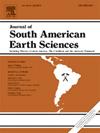巴西南部砾石河床沉积物粒度估算的不确定性分析
IF 1.7
4区 地球科学
Q3 GEOSCIENCES, MULTIDISCIPLINARY
引用次数: 0
摘要
了解沉积物粒度分布对于理解山地河流水系的水文地貌动力学至关重要。在砾石河床中进行地表沉积物采样的人工和自动化技术自然会产生不确定性。本研究旨在通过估算沉积物粒度分布的不确定性来理解野外行走技术(人工)和摄影测量分析(自动化)。测量在巴西南部Forromeco河沿岸的五个地点进行,包括现场卵石计数和基于无人机的摄影测量。为了计算名义直径,实地测量提供了沉积物的三个轴,而摄影测量只有两个轴。采用二项概率分布模型来估计沉积物大小的百分位数置信区间,从而能够评估所采用技术之间的不确定性。结果表明,与2轴方法相比,3轴测量通常得到更小的泥沙大小,反映了泥沙形状对最短轴量级的影响。现场统计分析表明,3轴计算的公称直径与2轴计算的公称直径没有差异。然而,四个地点的综合结果却显示出差异。无人机测量虽然有效,但往往忽略了更细的沉积物,高估了更大的沉积物,特别是在有植被障碍的地区。本研究强调了在解释无人机数据时考虑沉积物形状、沉积物配置和区域岩性的重要性。总体而言,3轴现场卵石计数方法可以更准确地表征Forromeco等山地河流的沉积物大小。该研究有助于了解山区泥沙动态,有助于水沙资源的管理,减轻与洪水有关的灾害。本文章由计算机程序翻译,如有差异,请以英文原文为准。
Uncertainty analysis of sediment size estimations in gravel-bed reaches in Southern Brazil
Understanding sediment size distribution is essential for comprehending the hydrogeomorphological dynamics of mountain river systems. Manual and automated techniques for sampling surface sediments in gravel-bed rivers can generate uncertainties naturally. This study aims to comprehend field-walking techniques (manual) and photogrammetric analysis (automation) by estimating uncertainties in sediment size distribution. Measurements were conducted at five sites along the Forromeco River in southern Brazil, including field pebble counting and UAV-based photogrammetry. To calculate the nominal diameter, field measurements provide three axes of the sediment, while photogrammetry only two. A binomial probability distribution model was applied to estimate the percentile confidence interval of sediment size, thus enabling an assessment of the uncertainty between the adopted techniques. Results indicate that 3-axis measurements generally yield smaller sediment sizes compared to 2-axis methods, reflecting the influence of the sediment shape on the shortest axis magnitude. Statistical analysis by site showed no differences between the nominal diameter computed with 3-axis or 2-axis. However, a four sites ensemble revealed discrepancies. Drone-derived measurements, while efficient, tended to overlook finer sediments and overestimate larger sizes, particularly in areas with vegetation obstacles. The present study highlights the importance of considering the sediment shape, sediment configuration and regional lithology when interpreting drone data. Overall, the 3-axis field pebble counting method provides more accurate sediment size characterization in mountain rivers like the Forromeco. This research contributes to the understanding of sediment dynamics in mountainous regions, aiding in the management of water and sediment resources, and mitigating flood-related disasters.
求助全文
通过发布文献求助,成功后即可免费获取论文全文。
去求助
来源期刊

Journal of South American Earth Sciences
地学-地球科学综合
CiteScore
3.70
自引率
22.20%
发文量
364
审稿时长
6-12 weeks
期刊介绍:
Papers must have a regional appeal and should present work of more than local significance. Research papers dealing with the regional geology of South American cratons and mobile belts, within the following research fields:
-Economic geology, metallogenesis and hydrocarbon genesis and reservoirs.
-Geophysics, geochemistry, volcanology, igneous and metamorphic petrology.
-Tectonics, neo- and seismotectonics and geodynamic modeling.
-Geomorphology, geological hazards, environmental geology, climate change in America and Antarctica, and soil research.
-Stratigraphy, sedimentology, structure and basin evolution.
-Paleontology, paleoecology, paleoclimatology and Quaternary geology.
New developments in already established regional projects and new initiatives dealing with the geology of the continent will be summarized and presented on a regular basis. Short notes, discussions, book reviews and conference and workshop reports will also be included when relevant.
 求助内容:
求助内容: 应助结果提醒方式:
应助结果提醒方式:


